ARETAI's Entry Level Loudspeaker Delivers Well-Balanced, Extended Response
...and effortless musicality
Getting good sound in a hotel room is always dicey and most of the time nearly impossible, even when an experienced exhibitor has previously used the same room. Sometimes it’s the electricity, sometimes the room’s décor has been redone and sometimes, well, it’s whatever sometimes makes your system not “happening” and there’s no good reason for it that you can think of, so you just pack it in for the evening and do something else, only to return next night and it’s sounding great!.
Yet every time I’ve heard these “bookshelf” sized Aretai speakers, whether at AXPONA, Warsaw or wherever, they’ve always sounded “right”. True, it’s easier to get good sound with smaller speakers that don’t produce the bottom octaves with full weight, if at all, but nonetheless something special seemed to be happening so I asked Aretai co-founder and speaker designer Jānis Irbe (whose design partner is Edgars Zvirgzdiņš) for a review pair, which were shipped in sturdy flight cases from Riga, Latvia where they are manufactured. The two founded the company in 2018.
Meanwhile at the recent AXPONA show Mr. Irbe showed a larger, floor standing speaker capable of below 30Hz response and placed on the long wall of a small hotel room it effortlessly produced impressively deep and clean bass. So, there’s that.
Aretai’s entry level Contra 100S is a relatively small speaker, approximately 8.25” x 15.75” x 10” (WxHxD) weighing a hefty for its size 33 pounds. It’s a two and a half way sealed box design featuring a pair of 6” polypropylene woofers sourced from SB Acoustics (an interesting multi-national speaker manufacturer), one rear-mounted that delivers to a few hundred Hz and is really the "woofer" and a more extended one in front that crosses over smoothly to the tweeter in the “upper midrange/lower high frequency” area between 5kHz-and 7kHz. Claimed low frequency extension is down to 30Hz.
Sealed box designs are less efficient than ported ones and the Contra 100S is no exception. It's rated at 87dB (up from its original 85dB rating when first introduced) with a nominal 4 ohm impedance, which is good news. I have no idea of the actual across the frequency range impedance or phase angle response (the measuring is one of the things I do miss about my previous endeavor) but at this point watts are relatively cheap. Aretai claims tube amps drive them fine and though I have a really nice Music Reference RM-200 MkII hybrid (tube output), I stuck with solid state.
Though Aretai doesn’t specify the upper crossover frequency or the slope (and I admit to forgetting the details the designer gave me at the various shows at which we’ve spoken), more conventional two way designs cross over from the woofer to the tweeter far lower down— usually around 1200Hz, to avoid both woofer break up at higher frequencies and crossing over in the critical midrange where the ear is particularly sensitive.
But I’m not a speaker designer so I’m just left to write that this speaker handles both male and female vocals so smoothly, effortlessly and seamlessly, it must be well above the upper fundamental frequency range of the female voice, or the speaker designer is a crossover design genius, or both, especially considering that the forward firing woofer is asked to handle such a wide frequency range and does so with low apparent colorations. Woofers asked to handle high frequencies are prone to audible break up, making mandatory, skillful filtering.
A gently flaired approximately 6 inches in diameter waveguide (horn) surrounds the neodymium magnet 1” “dimple dome” ring radiator tweeter (also from SB) that extends from the crossover point to beyond 25kHz, which should, to quote the old British comedy team of Flanders and Swan, “…please any passing bat”.
Before going further with the design basics, I need to say something about the speaker’s esthetic elegance. You don’t see a screw, a bolt, a seam, nothing! A dizzying variety of finishing options are available including high-gloss polished lacquer, matte solid wood veneers, as well as matte or high gloss colors but I found the matte black “base model” finish, with the solid wood waveguide option as supplied, particularly attractive. Also extremely well done is how the waveguide integrates into the speaker. It's a work of art in and of itself. Base price is $9000 with mat black cabinet and white waveguide. Add $1200 for the solid wood as delivered for a total cost of $10,200.
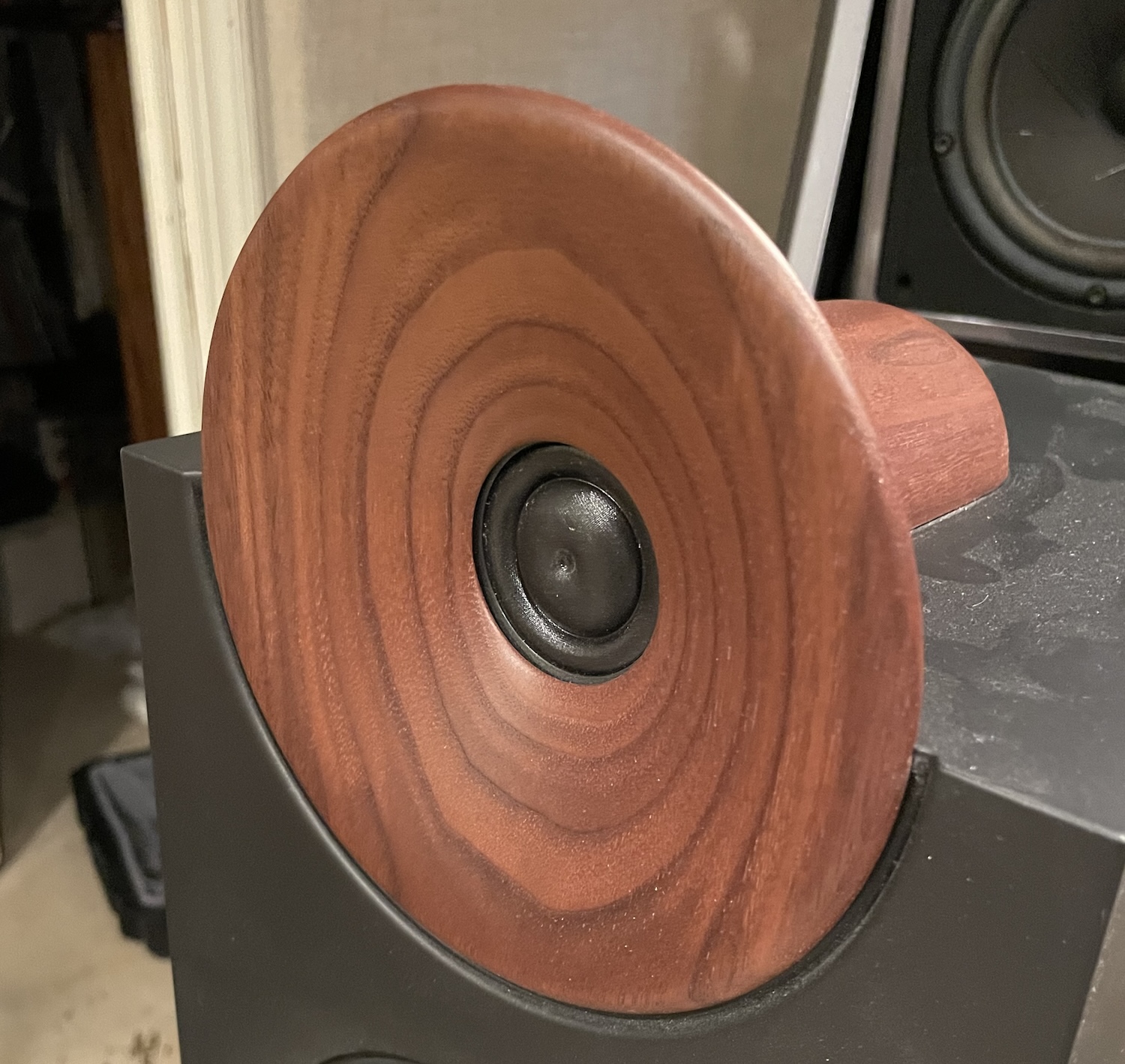 Pardon my dust
Pardon my dust
I never did get the full cabinet details but it’s safe to assume that the front and rear woofers set within gently flared baffle recesses are secured within thick machined MDF panels. Whatever other materials may be involved; these sealed boxes are dense, solid, tightly constructed, heavily damped constructions that stop dead a knuckle rap, leaving no boxy sounding residue. The Aretai website describes the enclosure as "structurally dampened and humidity proof". The cabinet sits atop an integral angled base that ever so slightly tilts the cabinet back from vertical, but it’s not likely enough to affect the driver timing, which must be a function of the crossover design. A damping pad applied to the speaker bottom isolates it from upon whatever it is placed. The speakers were supplied with a single pair of sturdy, 24 karat gold-plated binding posts. There's an available extra cost bi-amp double-terminal option.
What’s the waveguide’s purpose in this design? Off axis tweeters roll off, often steeply—the higher the frequency the greater the roll-off. Plus, the higher the frequency, the greater the directionality and "beaming". I'm not sure which SB ring radiator tweeter ARETAI uses in the Contra 100S but here's a graph of one of SB's ring radiator offerings:
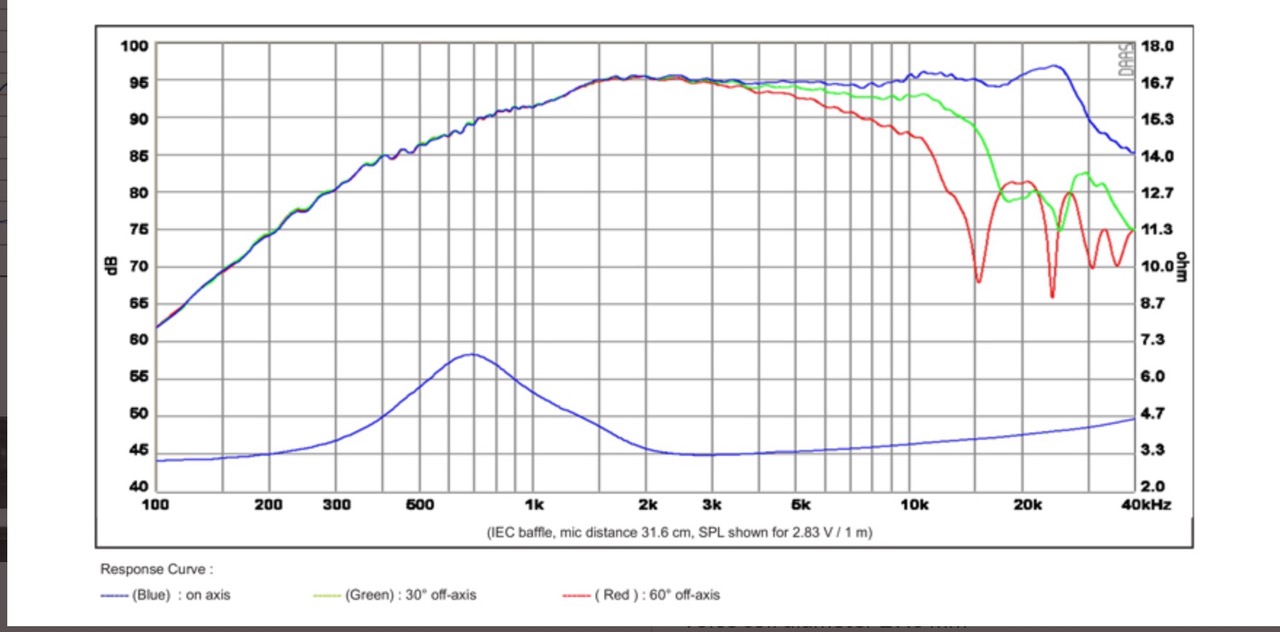 In a lively, or average listening room environment like a living room, reflections can help ameliorate the steep off axis roll-off and produce more balanced "lively" sound but it has to be carefully balanced with the direct on-axis tweeter output, while in well-damped rooms the roll-off can produce an overall dull sound. These are issues every listener and every loudspeaker reviewer constantly faces—as do manufacturers when they attempt to set up speakers in hotel rooms!
In a lively, or average listening room environment like a living room, reflections can help ameliorate the steep off axis roll-off and produce more balanced "lively" sound but it has to be carefully balanced with the direct on-axis tweeter output, while in well-damped rooms the roll-off can produce an overall dull sound. These are issues every listener and every loudspeaker reviewer constantly faces—as do manufacturers when they attempt to set up speakers in hotel rooms!
The gentle curvature of the Aretai waveguide should improve high frequency dispersion and smooth off axis response, bringing the red and green curves closer to the smoother, flatter on-axis response and help make the speaker more "room friendly" regardless of room conditions But why write "should"? The design has proven its case to me, in hotel rooms around the world and now at home so let's get to the "how'd they sound?" part!
I don't want to get into an argument about sealed boxes versus ported designs. Both can work well depending upon the skills of the people who implement them. However, sealed boxes are less efficient and require more power to effectively drive. That's just a fact. Ported designs can sometimes sound a bit sloppy and sealed boxes can sound "in the box" and boring. My reference ported speaker does not sound sloppy and spoiler alert, the Contra 100S does not sound boring and "in the box"!
How'd They Sound? Part
I set up the Contra 100S in three scenarios: in my main home theater, used with a 5 channel Parasound amplifier and a Wilson LOKE powered subwoofer, in my family room auxiliary home theater driving them with a relatively inexpensive Marantz receiver and a small REL subwoofer, and finally downstairs in main listening room where I was most worried because the speakers had to sit directly in front of the giant XVXs. I wasn't about to move them!
 I realize in some circles this would be tantamount to 'reviewer malpractice', but it's what I had to deal with and if the speakers didn't work in that scenario I'd bring them over to a friend's place.
I realize in some circles this would be tantamount to 'reviewer malpractice', but it's what I had to deal with and if the speakers didn't work in that scenario I'd bring them over to a friend's place.
I used a set of "vintage", very heavy, sturdy and well-damped Franklin & Howell stands Sumiko provided decades ago that have proven very useful for auditioning stand-mount speakers, putting them at just the right height for most every two-way I've tried them with. Getting the best performance from stand mount speakers especially high performance ones like the Contra 100S, requires a solid investment in stands. If you "cheap out" with stands you'll miss out on your chosen stand mount speaker's full potential.
Three very different scenarios in which the Contra 100S wouldn't you know it sounded great! Semi-nearfield, which is how I listened in the aux home theater scenario, proved that the waveguides were carefully considered. Close up, the speakers never sounded "horny", nor did they make their presence known when i sat more towards the back of the room. Instead the speakers delivered clarity and a pleasing timbral balance when back in February we watched some of The Grammys. Though the speakers of necessity were placed relatively close together, they produced a effective wide spread.
In the big home theater living room they played reasonably loud without strain on a few sound effects-heavy movies, aided by the LOKI subwoofer. Here, spread around 9 feet apart they produced a surprisingly wide, deep and tall soundstage that exceeded expectations. I watched "Maestro"—the Leonard Bernstein biopic—and heard all of the qualities that first attracted me to the Contra 100S. But obviously the real test and what I'll describe hearing in greater detail, was downstairs. On the company's website Aretai pictures them as near field desk monitors. I'm sure they are good that way too.
While speaker designs change, the room doesn't. I know my room pretty well after living here for twenty five years. Ported speakers do best where the XVXs are, which is almost in the corners close to the front wall and with the ports firing rearward (the XVX port can be configured in either direction), side firing designs usually produce the best bass further forward in the room with the woofers placed in a similar location to where the XVX end up. That makes sense. Sealed box designs usually do best there as well.
Everything in the bottom octaves benefits from the four Tube Traps hiding in the corners behind the XVXes. That's the 'secret weapon' in the room that helps make clean, deep bass production possible in what looks like an impossible scenario. A review of updated tube traps will post here soon. The originals were given to me by Harry Pearson in 1987!
Placed directly in front of the big speakers, (with their terminals shorted), driven by the big darTzeel amps immediately produced a positively hilarious, but I should have expected it result. The overall balance was such that I didn't feel the need to move the speakers further from the front wall, nor could I and moving them closer to the listening position attenuated the pleasantly balanced low frequency response so I left the 100S where I first put them but I did experiment with "toe-in" in my well damped room and found the best soundstage, imaging and everything was with the speakers aimed directly at the listening position, no "toe-out".
Eyes closed, the image was so wide, tall and well dispersed you could have almost fooled me into thinking I was listening to the big XVXes, and that's not hyperbole. I was expecting to have to make peace with a seriously diminished listening experience but I didn't. I shouldn't have been surprised.
At an overseas show once someone screwed up and before the first consumer entered the room the 1812 Overture played too loud blew a giant tower speaker's tweeter forcing the manufacturer to use an adjacent pair of small stand mounts. Many who entered the room were convinced the big speakers were playing. This can only happen with really well designed speakers capable of handling a lot of power and playing loudly. Those did. So did the Contra 100S.
The first record played was one I've referred to in a previous review, an Erato recording of six Vivaldi concertos for flute, oboe, violin and bassoon plus small ensemble, with the ever present Jean Pierre Rampal on flute. (Erato STU 70623).
The sound field size threw me! It was surprisingly tall and wide with the expected depth based on hotel room experience. I swear, you wouldn't know the big speakers weren't playing, so spacious and even-handed was the presentation. The woofer/tweeter blend was seamless, helping to effortlessly produce the ensemble in three dimensions and the space around it. The timbral balance didn't surprise me. I've heard it around the world but the scale of the spatial presentation did.
Next up was a recently acquired Pablo Joe Pass Portraits of Duke Ellington (Pablo 2310716) a 1975 release with Ray Brown and Bobby Durham on drums. It's a Pablo with no engineering credit. Whoever did the knobs did a superb job. Pass's electric hollow bodied guitar (I assume a Gibson ES175D but there's no photo) sounded vivid, warm and three dimensional between the speakers and Ray Brown's bass had effective weight and texture. I wasn't missing a thing here. It's easy to forget that though the box is compact there's a total of twelve inches worth of woofer working here (after publication the designer emailed and wrote "technically two 6-inch drivers don't equal a 12-incher, rather an 8.5-incher because the membrane area is a square function of diameter")! I did note the wattage reading on the darTzeel amps going higher than usual, but that was expected. Small speaker again playing big.
Who knows what prompts pulling out what records? For some reason to check female vocals I stayed away from the usual suspects (Norah, Billie, Linda, Julie, etc.) and picked tanto tempo (East West/Crammed 0927-47407-1) an obscure 2002 Bebel Gilberto record (she's his daughter) that's well recorded in Sao Paolo but the vinyl mastering was done with no "de-essing" so there's some annoying sibilant issues but otherwise it's a light breezy confection with acoustic/electronic arrangements that deserves a decent reissue.
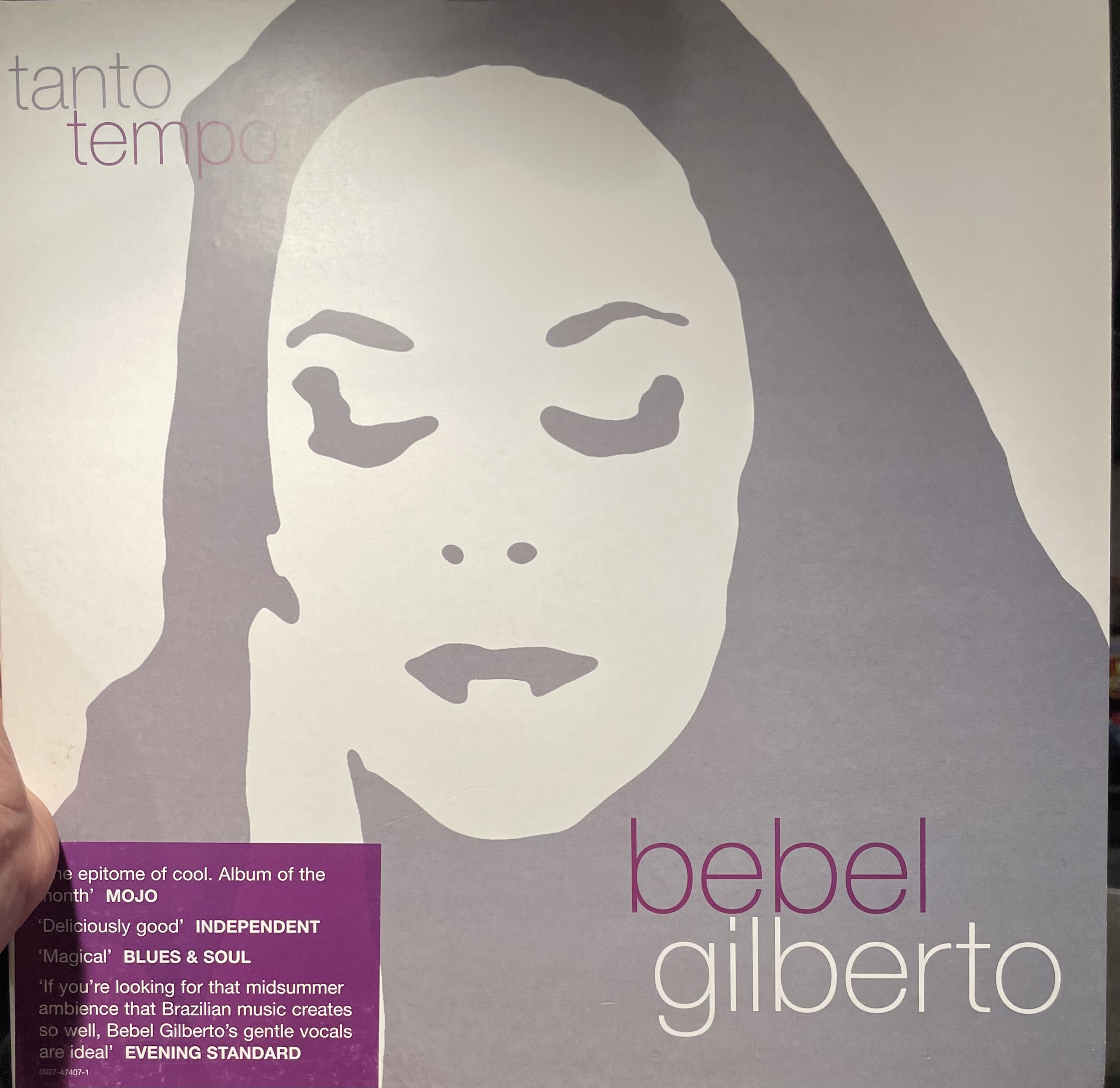 Bebel's voice was well served by the Contra 100S: smooth, silky, focused and believable between the speakers. No surprises, with the paper weight instrumental backdrop well back in space and equally relaxed.
Bebel's voice was well served by the Contra 100S: smooth, silky, focused and believable between the speakers. No surprises, with the paper weight instrumental backdrop well back in space and equally relaxed.
Next up was a male vocal test. This is where small two-ways often annoy with chesty colorations where speaker designers try to cheat the system with mid-bass parading as deep bass. I used Johnny Hartman's Once in Every Life (originally on Bee Hive, 1981 and reissued by Analogue Productions in 2016) and Leonard Cohen's haunting You Want It Darker (Columbia 88985365071S1)). No doubt a digital recording but the record sounds so much better than the either the CD or the stream and don't ask me why.
The Hartman recording done by the late Ben Rizzi at a small studio in Franklin Square, Long Island also features tight, deep bass from Victor Gaskin and Joe Wilder on trumpet and flugelhorn. It's a wonderfully three-dimensional recording that the Contra 100S effectively renders in terms of space and timbral and textural verisimilitude. You can see the instruments in space and feel them too, though here the bass loses a bit of weight and microdynamic "pop" compared to the big speakers. Hartman's voice, however, sounds so right, including the vocal sibilant sharpness. No chesty overlay and as he modulates up and down, the speaker follows honestly and without additive "tonality", though it does a more effective job at moderate SPLS. Crank it up, and some of the goodness gets caught up in strain. Years later Rizzi ran the much bigger Astoria Studios in Queens where I did narration on a test CD for TDK that David Letterman used in a show-long sketch that mocked the announcer (me!) but that's a story for another time!
The Cohen record is an astonishing set, especially the opener title song, with music by Patrick Leonard and words by Leonard Cohen. When Cohen sings "Henini Hineni" he goes incredibly low over an undulating bass line beat supplied by Leonard on keyboard bass. A haunting synagogue choir from Montreal supplies the background vocals. if you don't know the song or the album, it's octogenarian slow, epic and intimate. This Contra 100S's rendering of this song was on the mark, putting Cohen front and center, the choir well behind and Cohen's voice believable and again not clouded by lower mid bass excess. Better at low to mid level volume than pushed harder, but that was generally true with most of the music I auditioned.
Thanks to Patrick for giving me permission to publish this photo I hope you enjoy:
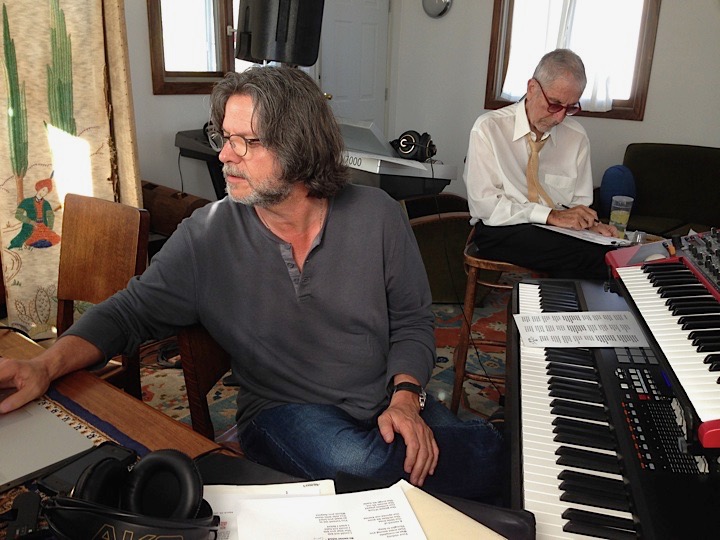
A final rock test was Blake Mills Heigh Ho (Verve/Record Collection B0021196-01), which a monumental sounding rock recording done at Ocean Way...yikes! ten years ago. Now that's frightening. Speaking of which the bass, the dynamics and the transient snap on the record are equally frightening.
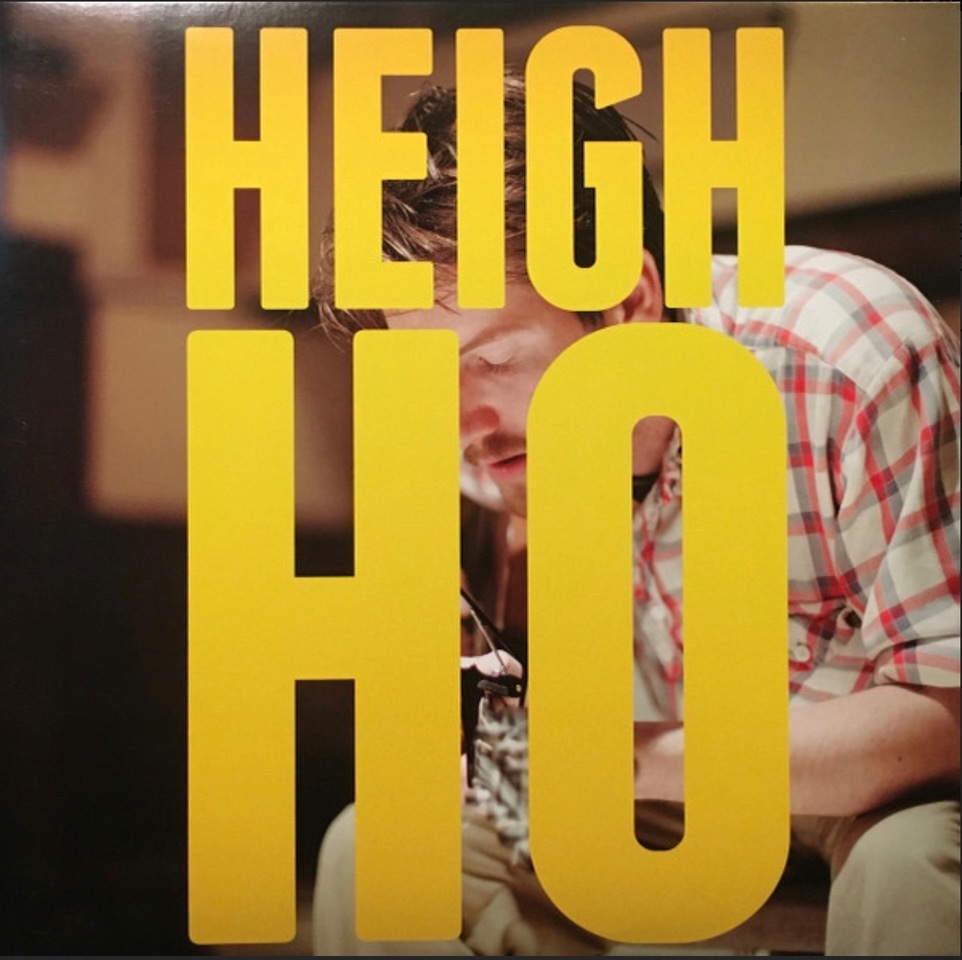
The opening track features Jim Keltner on thundering drums, Tony Berg on Ace Tone Rob Moose on strings and Mills on guitar, Guitarrón and vocals. Towards the end of the track there are bass depth charges and throughout the sharp transients demand speed and square wave-like articulation. The Contra 100S does well with the transients at lower SPLs, delivering sharp, crunchy string definition and hints at the bottom end weight and depth in a well-balanced way, but to get the power of what's on the record requires a bigger speaker played far louder and capable of blasting a lot more air. That's the small speaker reality. Nonetheless, this speaker surprised me by being able to approximate the track's power and crunch is a very balanced manner making it fully enjoyable—until you hear it on a big speaker.
Before packing up and shipping the speakers to Chicago for AXPONA, I listened to a variety of records, SACDs and streamed files. This speaker never failed to entertain and deliver musical pleasure. Even within the limitations of a small speaker, the Contra 100S never disappointed, even on "big" music iike symphonic works and film soundtracks as long as I didn't push the SPLs too high. The size of the presentation—width, height and depth, always impressed and helped make it possible to keep these speakers in play for weeks without feeling a need to return to the big Wilsons. Especially impressive was the complete lack of congestion. Of course once the big speakers were back in play the value of a big efficient speaker capable of effortlessly moving a lot of air became obvious as did the enormous price differential!
Conclusion
The uniformly enticing sound produced by these speakers under difficult show conditions around the world is what originally attracted me to this brand. Over time at shows I also found appealing designer Jānis Irbe's low key approach to demonstrating and discussing his designs with me and with consumers. He had confidence in his design approach and the results he was getting and with good reason!
The "one-sheet"'s hype free description complimented his in person approach. In it the speaker is described as "...allowing you to 'see' each instrument located right where the recording engineer intended it to be". At show and at home that proved true. In many ways the Contra 100S's spatial presentation reminded me of the old but still great imaging champ Spica TC-50.
The initial "no fuss" placement in my room proved to be the ideal location to deliver a surprisingly generous soundstage in width, height and depth. As good as it was at shows, at home it was even more impressive. These small speakers play big. And true to the claim from that very first record, the speaker's ability to present instruments appropriately on the stage was "spot on".
The "one-sheet" describes a soundstage of "impressive depth and width". True!
I didn't mention in the review the record I produced but the Contra 100S's rendering of Rufus Reid Presents Caelan Cardello while not quite as grand and convincing as through the big speakers, was close enough and far closer in scale than I could ever have imagined. It put me "there" in the Klavierhaus. The piano and bass too were as right as they could sound, though of course scaled back somewhat dynamically and otherwise as the small speaker's presentation would necessitate.
The "one sheet" also describes the bass delivered by the two six inch drivers as being "surprisingly deep and well-textured, combined with a coherent mid bass and treble balance". Also true. All of these characteristics were described refreshingly hyperbole-free.
In small to medium sized rooms, given sufficient amplifier power—and I think more than 100 watts minimum are required based on the wattage reading on my amplifiers as dynamic music played—the Contra 100S delivered everything promised by the manufacturer and then some.
I have hardly heard every, or even most circa $10,000 loudspeakers but were I in the market for same and if you are, don't put your money down until you have an opportunity to hear a pair of Aretai Contra 100S speakers. I spent months with them and thoroughly enjoyed the experience.
( At this time I'm not sure of American distribution but I did send this review pair to Pro Audio's Brian Tucker. As soon as I find out who's distributing I'll put the info in the "Manufacturer Info" box).
Specifications
Technical specification
Closed passive 2.5-way passive stand / desktop speaker
Frequency range, Hz: 32 –30 000
Nominal power, Watts: 100
Sensitivity, dB/1m/2.83V: 87
Nominal impedance, Ohms: 4
Dimensions, cm: H40/W21.5/D25
Net weight single speaker, kg: 16
24 carat gold plated speaker terminals
Vibration decoupling pad
Optional Bi-wiring /Bi-amping connectors (2 terminal pairs)
Warranty (parts & labour): 3 Years
Optional: 2 Years warranty extension
Manufacturer Information
As of 5/15/2024 these are Aretai's North American dealers:
True Audiophile
Portland, OR
Contact: Gary Alpern
(5 0 3) - 8 0 3 - 7 7 0 0
Pro Audio Ltd
Schaumburg, IL
Contact: Brian Tucker
(8 4 7) - 5 2 6 - 1 6 6 0
proaudio@comcast.net
Your Final System (YFS)
Denver, CO and Kingsport, TN
Contact: Kevin OBrien
(7 2 0) - 3 5 2 - 5 9 0 4
kevin@yourfinalsystem.com


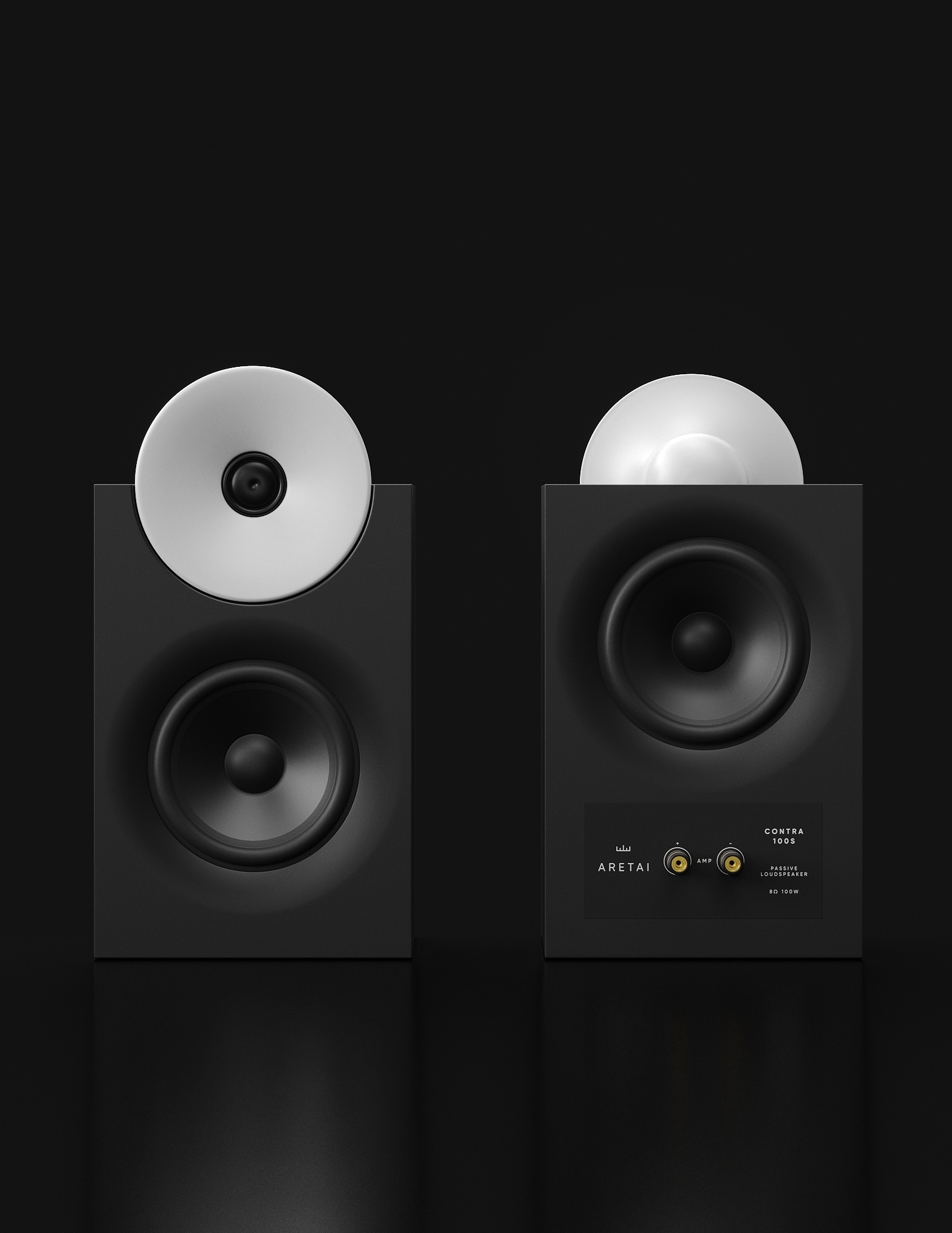







































.png)








